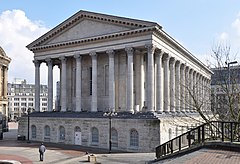Birmingham Town Hall
| Birmingham Town Hall | |
|---|---|
 |
|
| General information | |
| Type | Concert hall |
| Architectural style | Classical |
| Location | Victoria Square |
| Town or city | Birmingham |
| Country | United Kingdom |
| Coordinates | 52°28′46.56″N 1°54′13.59″W / 52.4796000°N 1.9037750°WCoordinates: 52°28′46.56″N 1°54′13.59″W / 52.4796000°N 1.9037750°W |
| Current tenants | Performances Birmingham Ltd |
| Construction started | 27 April 1832 |
| Opened | 7 October 1834 |
| Renovated | 1996—2007 |
| Cost | 25,000 Pound sterling |
| Renovation cost | 35 million Pound sterling |
| Owner | Birmingham City Council |
| Design and construction | |
| Architect | Joseph Hansom & Edward Welch |
| Main contractor | Thomas & Kendall |
| Designations | Grade I listed |
| Renovating team | |
| Architect | Rodney Melville Partners |
| Renovating firm | Wates Group |
| Other information | |
| Seating capacity | 1,086 |
| Website | |
| http://www.thsh.co.uk/ | |
Birmingham Town Hall is a Grade I listed concert hall and venue for popular assemblies opened in 1834 and situated in Victoria Square, Birmingham, England.
The first of the monumental town halls that would come to characterise the cities of Victorian England, Birmingham Town Hall was also the first significant work of the 19th-century revival of Roman architecture, a style chosen here in the context of the highly charged radicalism of 1830s Birmingham for its republican associations. The design was based on the proportions of the Temple of Castor and Pollux in the Roman Forum. "Perfect and aloof" on a tall, rusticated podium, it marked an entirely new concept in English architecture.
It was created as a home for the Birmingham Triennial Music Festival established in 1784, the purpose of which was to raise funds for the General Hospital, after St Philip's Church (later to become a Cathedral) became too small to hold the festival, and for public meetings.
The hall underwent a major renovation between 2002 and 2008. It now hosts a diverse programme of events including jazz, world, folk, rock, pop and classical concerts, organ recitals, spoken word, dance, family, educational and community performances, as well as annual general meetings, product launches, conferences, dinners, fashion shows, graduation ceremonies and broadcasts.
Two sites were considered by the Birmingham Street Commissioners for the construction of a concert hall in the city; Bennetts Hill and the more expensive Paradise Street site. The latter was chosen and a design competition was launched which resulted with the submission of 67 designs including one by Charles Barry, whose design for the King Edward's School on New Street was then under construction.
...
Wikipedia
